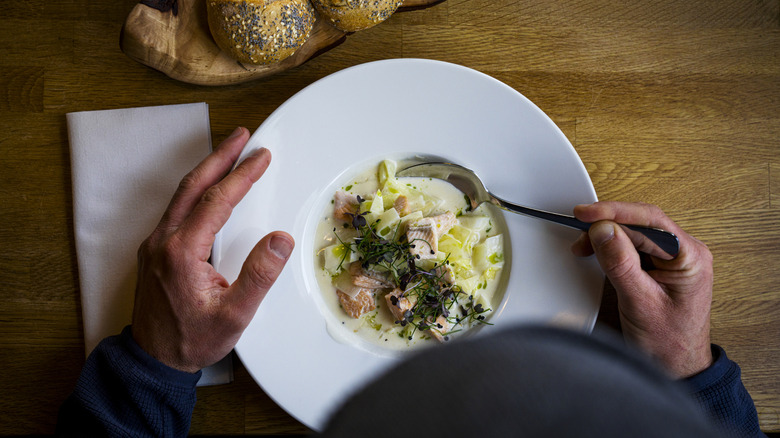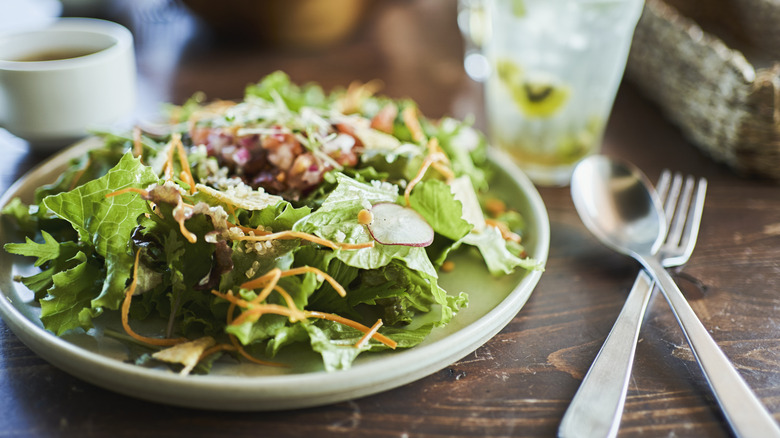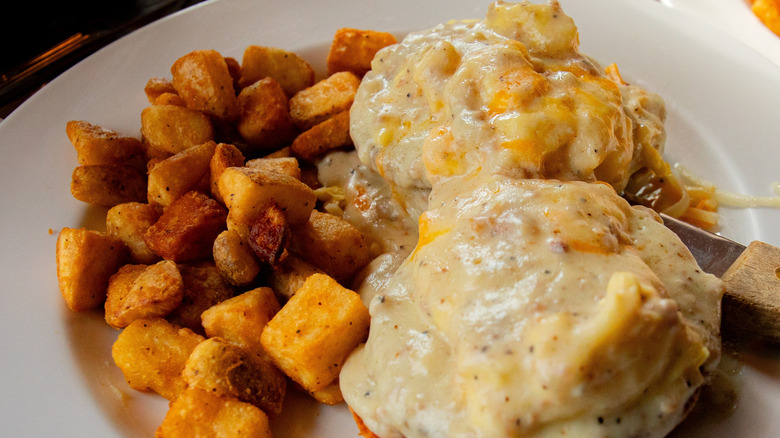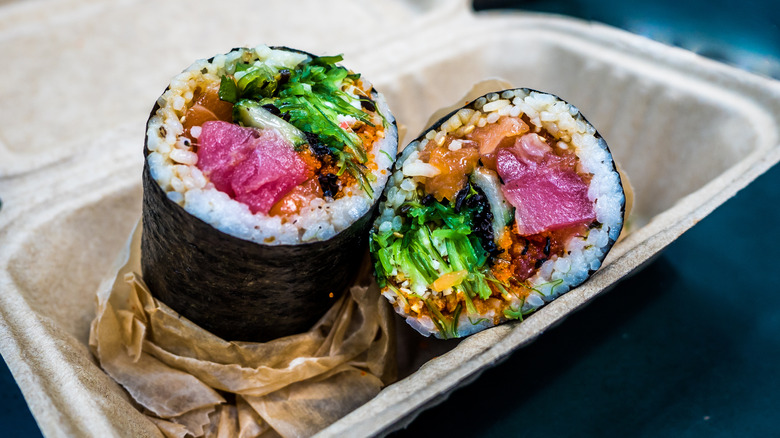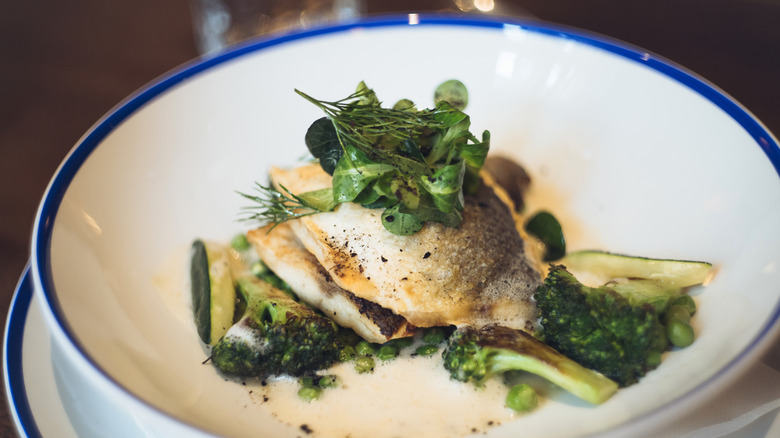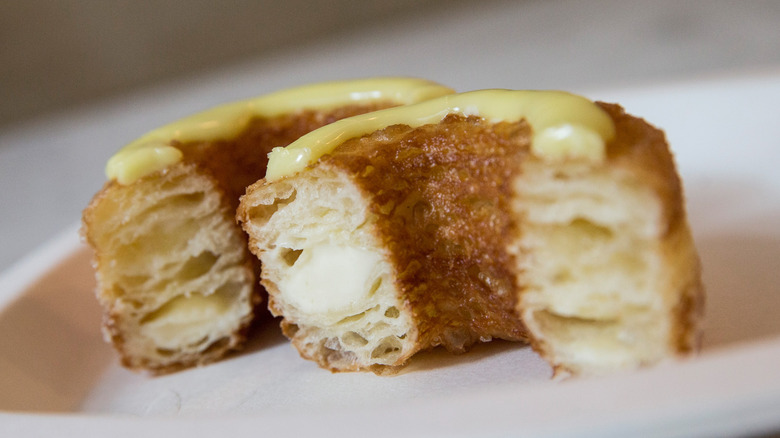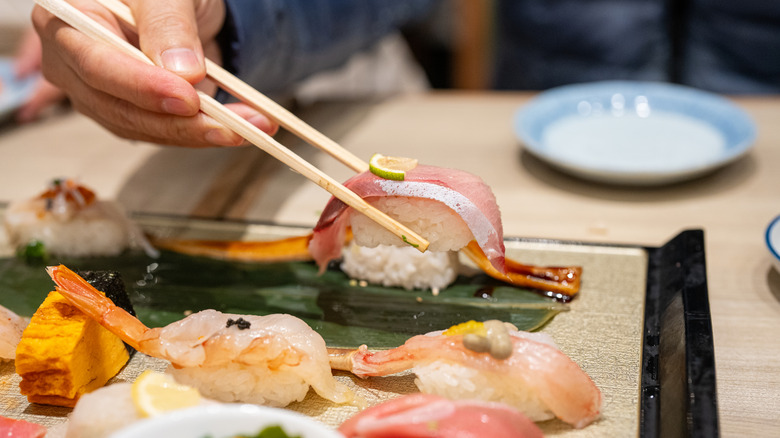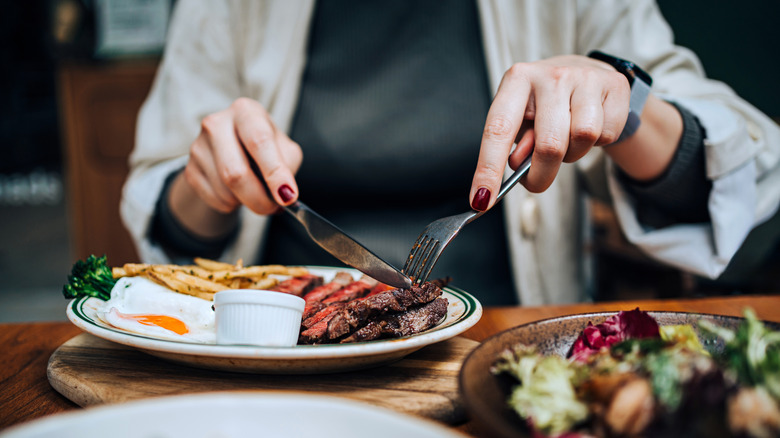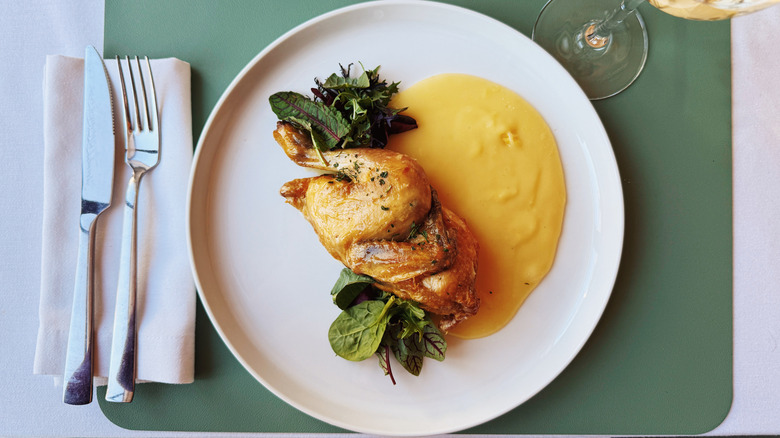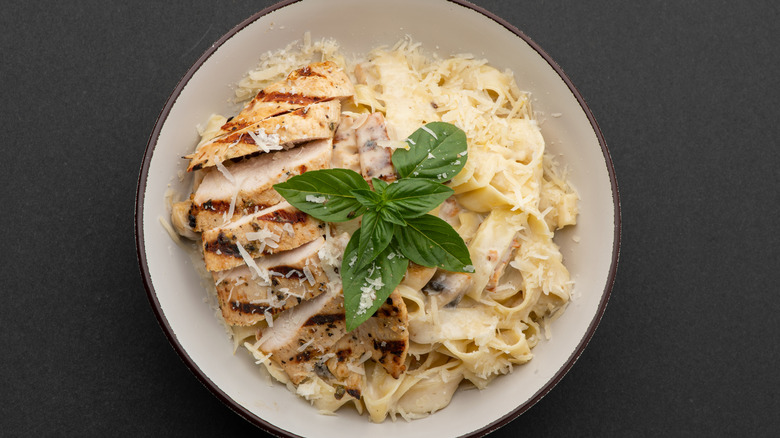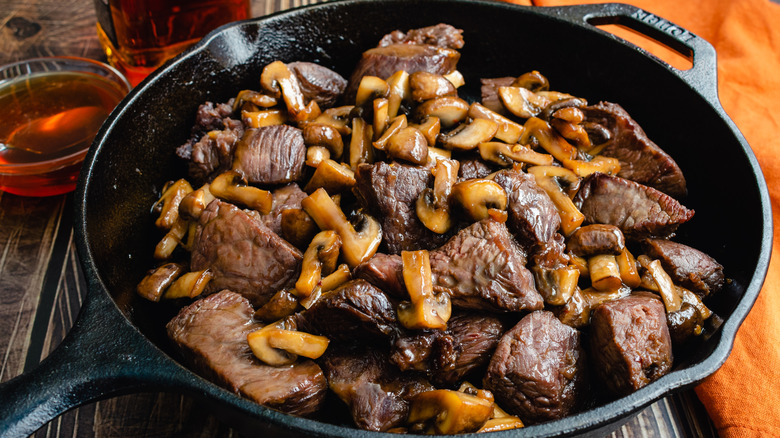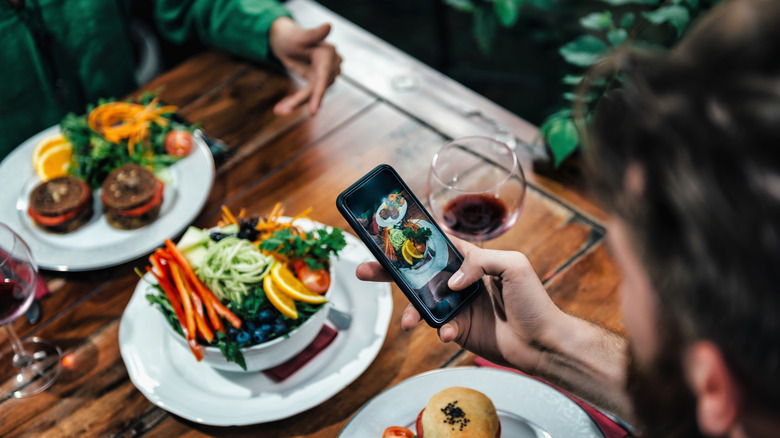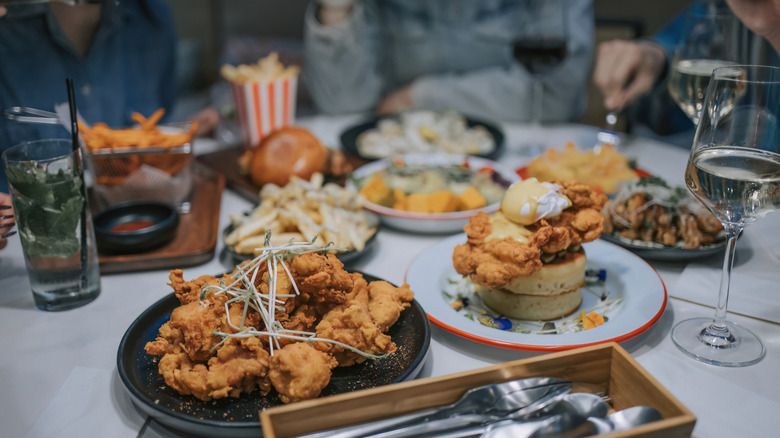14 Dishes Chefs Never Order At Restaurants
We may receive a commission on purchases made from links.
Maybe you're ordering at a new-to-you restaurant where you know you'll be dropping a pretty penny when the bill comes, and you want to make the best selection possible. Maybe you seem to have fallen into a rut of bad dining experiences. Whatever the case may be, you wish you had some expert insight into what you really should — or, in this case, shouldn't — be ordering when you're dining out. Enter professional chefs who have insider knowledge and very strong opinions about what menu items you should avoid at restaurants.
We spoke with a range of chefs representing an array of cooking styles and restaurants to hear what they personally never order off a menu, and some of their answers are pretty surprising. In fact, some of the dishes these chefs never order at restaurants are actually the same dishes that other chefs swear you should always order. They each have their reasons, so read on for the scoop on the menu items you may want to skip during your next restaurant meal.
1. Soup du jour
As Chef Jon Davis, head chef at City Grocery in Oxford, Mississippi, told us, "The one thing I do not order at restaurants is the soup du jour. Was it really made today? How long has it been in the steam well? Did the prep cook cool it down properly? It's a crap shoot I'm not willing to take. I'd rather make soup at home." Chef Davis isn't alone in his thinking. The soup of the day is one of the menu items you'll never see Gordon Ramsay ordering at a restaurant, either, with the celebrity chef citing similar reasons.
Furthermore, Ramsay recommends asking your waiter what the soup du jour was yesterday, as their answer can clue you into how fresh and daily that soup special really is. Additionally, ask what the general specials were over the previous days, if you really want to get an idea of the freshness of the ingredients. If the specials were items like roast chicken and veg, and now the soup of the day is a chicken vegetable soup, that's a big red flag that the kitchen is using older, leftover ingredients to make the soup, instead of preparing something worthy in its own right.
2. House salads
There's another meal starter to avoid if you're not looking to eat the kitchen's leftover goods: the house salad. According to Chef Suhum Jang, co-owner and managing partner of Hortus NYC, this is an item he personally avoids ordering, and he just tends to steer clear of restaurant salads overall. He told us, "I've seen restaurants repurpose leftover scraps from other dishes as salad ingredients, which is off-putting. Additionally, the base greens aren't always fresh, and heavy dressings are often used to mask this lack of quality."
Plus, when it's so easy to make a great salad at home, why order one when you're splurging on a nice meal? Try some easy salad recipes this weekend and make your own salad dressing, too. Just be sure that you're checking potential recalls for any of your salad greens before using and eating them, as past salad recalls have affected millions.
3. Biscuits
In some cases, chefs avoid ordering certain items when dining out for a very good reason: They can make it better themselves at home. That's the case for Oakland's Chef Rene Johnson, owner of BlackBerry Soul Catering, when it comes to biscuits. She said, "I am the undisputed Queen of Biscuit Makers, and I can't set myself up like that. Biscuits are one of the few things I actually size up when I visit restaurants, and nine times out of 10, I end up mad — like, did I just bite into a dry, gummy paper towel? Nope. Ordering biscuits out is a guaranteed disappointment for me. I'll stick to my own, thank you very much."
Of course, most of us don't have quite the same biscuit-making prowess as Chef Johnson. Making biscuits at home doesn't have to be a battle, though. If you're looking for the easiest and most convenient homemade biscuits possible, try a two-ingredient biscuit recipe or a three-ingredient biscuit recipe that utilizes just flour, heavy cream, and butter.
4. Fusion dishes
Fusion cuisine really became popular in the 1990s, as chefs utilized a range of unique ingredients, mashing together cultural bites to craft something brand new, to varying results. Since then, fusion cuisine has evolved to give us some of the most interesting social media-viral foods to date. A French croissant meets an American donut for the cronut, for example. However, pause before you head to a fusion restaurant or order a menu item that attempts to throw two very different cuisines or ingredients together, like a burrito and sushi, or ramen and a burger.
Chef Peter He, head chef at Meili in Brooklyn, notes he personally avoids these complicated dishes that try to fuse five cuisines onto one plate. "They often sound exciting on the menu but rarely deliver balance or depth. I'd rather have one cuisine done well than a confusing mix of flavors that feels like it's trying too hard," he says.
5. Cooked or farmed fish
Chefs spoke out against two types of seafood items when asked what they avoid: cooked fish and farmed fish. About the former, Chef Chaz Lindsay, owner and executive chef of Pulito Osteria and Rowan's, in Jackson, Mississippi, said, "I generally avoid cooked fish unless the restaurant is known for it. Properly cooking fish is an art form — one of the most difficult skills to master, in my opinion. More often than not, I find it underwhelming."
As for the latter, Chef Megan Keno of FOX's "Next Level Chef" and author of "Cast Iron Gourmet: From Kitchen to Table, Made with Love," said that she always sees words like "farm-raised fish" as a big red flag, specifically pointing toward tilapia as a no-go. She further notes that she's very mindful of sustainable, wild-caught fish practices. Tilapia has grown in popularity due to its affordability, but it's easily one of the top cheap fish that aren't worth buying.
Chef William Eick of Matsu painted his avoidance of fish on restaurant menus in broader strokes, saying that he steers clear of all fish dishes unless the fish is locally sourced or the restaurant boasts a spotless reputation.
6. Eggs Benedict
When Chef Clifton Dickerson of the Auguste Escoffier School of Culinary Arts admitted that he never orders eggs Benedict when dining out, it came as no surprise. Many chefs have spoken out against the ills of an hollandaise sauce, including Anthony Bourdain.
Dickerson clarified, "Don't get me wrong — I love a good Benedict — but hollandaise sauce is temperamental, especially during a busy brunch rush. If it's not made to order or held just right, you can end up with a broken sauce or something that's been sitting too long."
Along the lines of sitting too long, sauces like hollandaise are one of the unhealthiest menu items at some restaurants, not only due to the excess calories they can add to a meal, but also because they come with a certain health risk. If the hollandaise is left at the incorrect temperature, the raw egg yolks contained within can go bad, potentially resulting in a bad case of salmonella-related food poisoning.
7. Trending foods
They come and they go, showing up on menus for brief moments in time before they're gone for good. Think extravagant boards filled with the latest social media foodie craze, like tinned fish or butter. Think colorful, over-the-top, sky-high burgers or milkshakes overflowing with sweet treats. Trending foods, as tempting as they might be, though, aren't worth your time, according to multiple chefs.
Chef Dickerson said that if a dish looks like it was made more for Instagram than for eating, it's a hard pass. Similarly, Chef Jorge Dionicio of Kansha in Manhattan said, "I usually skip anything that feels overly processed or gimmicky things that rely more on presentation than substance. I value food that's rooted in intention, not trend. I want to taste the ingredient, not just the concept." So, if it's something that you've seen all over your social media feed recently, you might just want to refrain from ordering that specific item.
8. Sushi
Chef Jorge Dionicio also told us that he never orders sushi when dining out unless he knows and respects the chef in question — and with Dionicio's background (he's a classically trained Edomae sushi chef and competed in the World Sushi Cup), that's probably advice to learn from. He explained, "I'm very particular about how fish is handled, aged, and presented. If those elements aren't respected, the experience can be disappointing."
Perhaps you don't share Chef Dionicio's high standards, but even so, there are still some basic sushi restaurant red flags you should watch out for. For example, if the restaurant smells overly fishy or if there's a chemical aroma when you walk inside, then that's a big sign that you could be served some bad seafood, seafood that could make you seriously ill. Additionally, if the sushi rice is dry, clumpy, or puffy, it may be a sign that it's likewise not suitable for eating.
9. Steak
Steak? Really? It's a go-to menu selection. It's what you anticipate eating when you're going out for a really special occasion. It's your "treat yourself" order — and yet, one chef says they avoid it when dining out.
According to Chef Luke Shaffer, an instructor at the Auguste Escoffier School of Culinary Arts, "I never order steaks when I dine out. Why? I can cook a darn fine steak at home. Why spend a huge markup for something that's not going to be exponentially better than what I can do? Especially if there are more interesting options on the menu. Now, I will make an exception for something like an A5 Wagyu, but that's not really a steak, it's an experience."
If you're really looking for an experience, go ahead and order a spectacular steak in a fine-dining setting. However, if you trust yourself in the kitchen or at the grill, consider fine-tuning your steak-cooking skills at home, so you can enjoy other items on the menu when dining out, like Chef Shaffer.
10. Chicken
Chef Luke Shaffer also said he never orders chicken breast when dining out — even though some chefs call chicken one of their go-to orders. Shaffer's reasoning? He notes that the odds aren't in your favor when ordering chicken at a restaurant, as it may just come out "sawdust dry." Plus, he mentions, most restaurants have something far more interesting to offer, so you can save the bland, boring, non-indulgent chicken breast for when you're at home.
His colleague at the Auguste Escoffier School of Culinary Arts, Chef Susan Yurish, concurred, saying you can probably find a more interesting protein on the menu. If you're really craving chicken, she recommends opting for a chicken thigh, which will offer more flavor than a chicken breast.
Chef Justin Robinson, from Food Network's "Iron Chef Showdown" and Fox's "MasterChef," summed it up nicely: "It's one of those proteins that's often overcooked and under-seasoned unless handled with intention. If I'm dining out, I want to try something I can't easily recreate at home — or at least something that brings a new perspective. Give me flavor, technique, and a little risk. If I feel like I could've made it at home, it would be a wasted dining experience."
11. Alfredo
Whether it's chicken Alfredo or just straight-up fettuccine Alfredo, you might want to avoid this Italian-American staple next time you're craving some carbs. According to Chef Susan Yurish, there are so many other ways to elevate pasta, and Alfredo sauce isn't going to do it for you.
If you're reluctant to give up your beloved Alfredo just yet, at least try to ensure you're getting authentic Italian Alfredo sauce. In the United States, Alfredo sauce is typically rich, buttery, creamy, and reliant on three basic ingredients: butter, Parmesan, and cream. However, the biggest Alfredo sauce misconception is that it contains any cream. The original, Italian Alfredo sauce recipe contains just two ingredients: butter and Parmesan (and maybe some pasta water, if you're following a three-ingredient Alfredo sauce recipe). That's how Roman chef Alfredo di Lelio made it in 1908, when he invented Alfredo sauce in hopes that it might inspire his wife to eat after giving birth to their child.
12. Beef tips
You see this offering on a range of menus, but what really is a beef tip? It consists of small, nearly bite-sized bits of beef, sometimes served marinated and grilled, other times smothered in a gravy. While some cuts of meat are best for beef tips (a filet or tenderloin, for supreme tenderness), there's no consensus on what part of the cow the beef tips should come from. This lack of clarity leads Chef Christopher Diehl of Auguste Escoffier School of Culinary Arts to avoid this dish when dining out.
"I would never order any dish made with 'beef tips' or any dish that has a component I can identify as leftovers," he said. "I know that the place can use these dishes as an outlet for scraps, and as much as I would love to help with food cost, I'm going for a main entree that wasn't an afterthought."
13. Out-of-season dishes
Chef Yuu Shimano of Restaurant Yuu in Brooklyn told us, "I tend not to order dishes that ignore the season. If I'm going out to eat, I want to enjoy ingredients that are at their best at that moment." This falls in line with what chefs reported when we asked them about the menu items they always order when dining out. Time and again, they said they always opted for a seasonal menu item that highlighted fresh, local ingredients.
Beyond the fact that seasonal dishes are often tastier and chef-approved, there are many more reasons to dine seasonally. For example, if a restaurant is buying food from local farms, eating seasonally can support your local producers and economy. Additionally, local, seasonal food doesn't need to be transported as far, cutting down on your meal's carbon footprint. Likewise, it can be easier to find foods that are raised sustainably or in a way that aligns with your values when you eat locally and seasonally.
14. Unhealthy food
Chef Yuu Shimano also keeps an eye on his health when dining out (after all, being a chef is a demanding job!), but that doesn't mean he's not enjoying the best the culinary world offers. Instead, he just steers clear of fast food.
Chef Mawa McQueen of Crepe Therapy Café agrees and says, "I never order anything processed or pre-made. I believe food should nourish you, not weigh you down. I stay away from anything that feels overly complicated or artificial. If I see a dish that screams 'convenience' instead of 'craft,' I pass. I know what it takes to make food from scratch with real ingredients — and that's what I expect when I dine out."
Don't have quite the same eye for identifying when a dish is artificial or too convenient to be worth your time and money? No matter where you're dining, there are always going to be certain menu items that are healthier than others. For example, if you're dining at an Italian restaurant, healthy Italian menu items include pastas sporting simple sauces or vegetable-rich soups, while some of the unhealthiest menu items will typically be stuffed pastas or pasta covered in creamy sauces.

